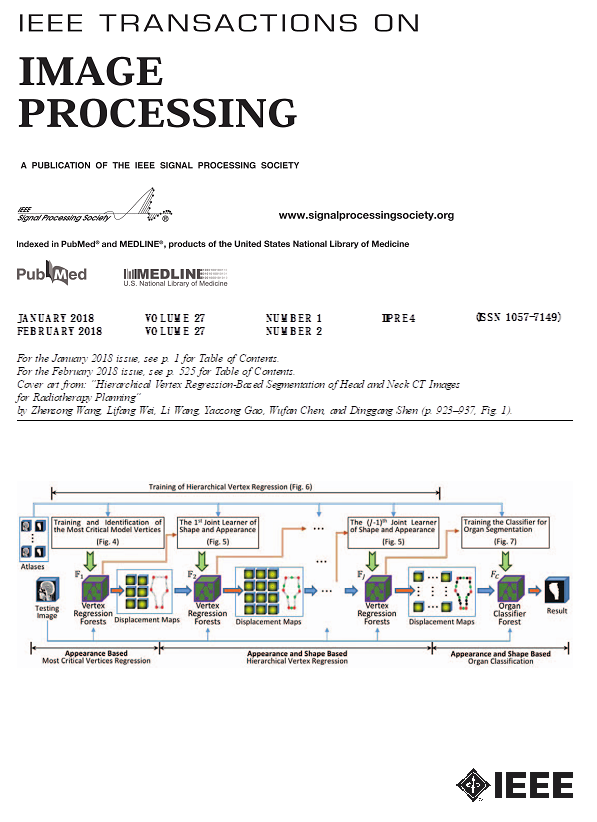Tone Mapping Beyond the Classical Receptive Field
IF 13.7
1区 计算机科学
Q1 COMPUTER SCIENCE, ARTIFICIAL INTELLIGENCE
引用次数: 3
Abstract
Some neurons in the primary visual cortex (V1) of human visual system (HVS) conduct dynamic center-surround computation, which is thought to contribute to compress the high dynamic range (HDR) scene and preserve the details. We simulate this dynamic receptive field (RF) property of V1 neurons to solve the so-called tone mapping (TM) task in this paper. The novelties of our method are as follows. (1) Cortical processing mechanisms of HVS are modeled to build a local TM operation based on two Gaussian functions whose kernels and weights adapt according to the center-surround contrast, thus reducing halo artifacts and effectively enhancing the local details of bright and dark parts of image. (2) Our method uses an adaptive filter that follows the contrast levels of the image, which is computationally very efficient. (3) The local fusion between the center and surround responses returned by a cortical processing flow and the global signals returned by a sub-cortical processing flow according to the local contrast forms a dynamic mechanism that selectively enhances the details. Extensive experiments show that the proposed method can efficiently render the HDR scenes with good contrast, clear details, and high structural fidelity. In addition, the proposed method can also obtain promising performance when applied to enhance the low-light images. Furthermore, by modeling these biological solutions, our technique is simple and robust considering that our results were obtained using the same parameters for all the datasets (e.g., HDR images or low-light images), that is, mimicking how HVS operates.超越经典感受域的音调映射
人类视觉系统(HVS)初级视觉皮层(V1)中的一些神经元进行动态中心环绕计算,这被认为有助于压缩高动态范围(HDR)场景并保留细节。我们模拟了V1神经元的这种动态感受野(RF)特性,以解决本文中所谓的色调映射(TM)任务。我们方法的新颖之处如下。(1) 对HVS的皮层处理机制进行了建模,建立了基于两个高斯函数的局部TM运算,这两个函数的核和权重根据中心环绕对比度进行调整,从而减少了光晕伪影,有效地增强了图像明暗部分的局部细节。(2) 我们的方法使用了一个跟随图像对比度水平的自适应滤波器,这在计算上非常高效。(3) 皮层处理流返回的中心和周围响应与亚皮层处理流根据局部对比度返回的全局信号之间的局部融合形成了选择性增强细节的动态机制。大量实验表明,该方法可以有效地渲染对比度好、细节清晰、结构逼真的HDR场景。此外,当应用于弱光图像增强时,所提出的方法也可以获得有希望的性能。此外,通过对这些生物解决方案进行建模,考虑到我们的结果是使用所有数据集(例如,HDR图像或微光图像)的相同参数获得的,即模拟HVS的操作方式,我们的技术简单而稳健。
本文章由计算机程序翻译,如有差异,请以英文原文为准。
求助全文
约1分钟内获得全文
求助全文
来源期刊

IEEE Transactions on Image Processing
工程技术-工程:电子与电气
CiteScore
20.90
自引率
6.60%
发文量
774
审稿时长
7.6 months
期刊介绍:
The IEEE Transactions on Image Processing delves into groundbreaking theories, algorithms, and structures concerning the generation, acquisition, manipulation, transmission, scrutiny, and presentation of images, video, and multidimensional signals across diverse applications. Topics span mathematical, statistical, and perceptual aspects, encompassing modeling, representation, formation, coding, filtering, enhancement, restoration, rendering, halftoning, search, and analysis of images, video, and multidimensional signals. Pertinent applications range from image and video communications to electronic imaging, biomedical imaging, image and video systems, and remote sensing.
 求助内容:
求助内容: 应助结果提醒方式:
应助结果提醒方式:


